RockyMtnMT
Official LRH Sponsor
Last week we had a film crew out to do a video on load development. While they were here, we also did a video of a gel test with the Hammer Hunter 199g 30cal compared to a 215g highly reputable long range hunting bullet. For the test we used two different rifles. For the short-range test we used a Browning Hells Canyon Long Range in 300 Remington Ultramag with a 1-8" barrel twist. This rifle was brand new out of the box, had never been fired prior to working up the loads for the test. For long-range testing we used a 30-06 semi-custom rifle with a 1-9" twist on a Tikka action.
The first goal for the testing was to simulate a high velocity impact, for each bullet, using top end loads in a factory 300 Ultramag off the shelf rifle, that would be common to hunters wanting to hunt to long range. The second goal was to simulate a long-range impact, that would be below 2000 fps for each bullet.
We started out by loading the 30-06 with each bullet. We were aiming to get about 2200 fps for the 215g bullet and about 2300 fps for the 199g Hammer Hunter. This would put them as close as possible to the same impact velocity at 300y, based on the bc for each bullet. We used Peterson brass for each rifle. For the 215g bullet we loaded with Varget at 39g for a vel of 2210 fps. Es was pretty wide but accuracy was solid sub moa, close to .5" at 100y. For the 199g Hammer Hunter we also loaded Varget at 40g for an average vel of 2320 fps. Also a pretty wide es but still running solid sub moa at 100y. I was actually surprised that both bullets shot ragged holes with such a mild load. At these velocities the stability factor for each bullet calculated at sea level was 1.65 sg for the 215g bullet and 1.48 sg for the 199g Hammer Hunter. A little lower stability for the Hammer Hunter, which could be a bit of a handicap. We now have the loads done for the long range test.
Next, we worked up loads for each bullet with the 300 RUM. Idea here was to get as much out of each bullet as we could. For both bullets we used ADG brass and Fed 215m primers. For the 215g bullet we used rl33 at a top end of 103g with a vel of 3170 fps. I was hoping for 3200 fps, so we got pretty close. For the 199g Hammer Hunter we used n570 at a top end of 102g with a vel of 3440 fps. Both loads were top end and should not be loaded without starting 10% lower and working up. These loads were not pushing the ADG brass too hard. Primer pockets were still tight. Now we are ready to go smack some gel.
Gel testing was done with Clear Ballistics 10% gel blocks. We used their 18"x8"x8" blocks. For each test we put two blocks end to end with a box of newspaper behind that, in case we had a bullet fully penetrate both blocks. We first fired the 215g bullet, after checking to make sure the hollow point was open and not plugged with lead. Got a good hit and the bullet performed as I think it is supposed to. Entered the block and initiated expansion at 2" with a very large wound and the retained portion stopped just before exiting the first block. Total penetration of almost 18". The permanent wound made it to about 11" with a very small wound to the stopping of the bullet. All in all, I thought this was pretty good. Which is really what we want when comparing our bullet to another. We want to compare to bullets that have a reputation for great performance. Impact velocity for the 215g bullet at 100y was 3044 fps, calculated from advertised bc and the atmosphere at the shooting location.
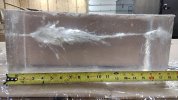
The blob at the end of the block is from me cutting out the retained portion. Should have taken the pic before I cut it out.
Next we fired the 199g Hammer Hunter. The pure copper Hammer Hunter initiated expansion at 2" and created a very large wound with the bullet exiting the top of second block at 33" of penetration. The bullet exited the top of the block as the blocks were launching into the air from the impact. Should have held them down, but it doesn't look as cool for the video. Luckily it was caught in a catalog in the box of paper. Stuck in the catalog with the base of the bullet just exposed. At 100y the impact vel of the Hammer Hunter was at 3285 fps. Wound channel from the Hammer Hunter was very large to about 13" and then moderately large to 27" and the retained shank made a small permanent wound to 33". This is the kind of performance we expect at very high vel impacts.
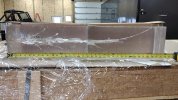
Now for the 300y low velocity impact testing. We started with the 215g bullet. We adjusted the scope for the expected drop and fired on a paper target to confirm POI. In the dot, so here we go. Took the next shot at the gel, after checking to make sure the hollow point was open and hit center of the block. Muzzle vel reading from the Labradar was 2157 fps putting the impact vel at 1856 fps. Right in the velocity range we wanted to test. On inspection of the gel blocks we found that the 215g bullet entered without any permanent wounding until the bullet penetrated 9.5". At this point there starts to be a permanent wound and then you can see where the tip of the bullet folded over and broke off at about 10". The separated tip traveled to 14". It appears that just after the tip broke off the jacket and the core separated. The core went down and stopped just inside the second block at 19" and the jacket went on to stop at 29". You can see that there is another wound coming in form the left. That was from the next test as we turned the block around. Both projectiles happen to stop at the same point in the block and you can see the scar from me digging it out.
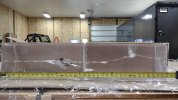
Time now to confirm the drop at 300y with the 199g Hammer Hunter. Took the shot and hit a bit high so came down and hit a bit low. Needed to come up a click and I think I clicked down. Oops. Tuned out ok as I hit bottom half of the block but everything stayed in the block nicely. Muzzle vel for this shot was 2233 fps putting the impact vel at 1870 fps. Perfect! Within 14 fps of each other. Don't think we could have got them any closer to the same impact velocity. The Hammer Hunter initiated expansion at 2.5" into the block and created a fairly large permanent wound channel for 15" and the retained shank came to rest at 24" of penetration. This again is exactly what we expected to see.
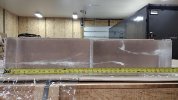
Here is some pics of the recovered bullets at each range along with an unfired bullet for reference.
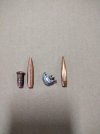
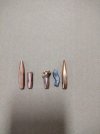
After the gel test we went to the mountains to shoot the two bullets across the canyon at 867y out of the 300 rum. Shot the 215g bullet first. Hit an moa high and 3 moa to the right. Dialed the corrections and put it on the rock. Next fired the 199g Hammer Hunter. Took a couple of moa off and held the same wind. Wasn't too concerned with elevation with these shots, but more concerned with how much wind hold would be needed. The 3moa of wind hold was perfect for both bullets. We will see how the video turns out on the long-range shooting. Hopefully you can see the bullet impacts well. The video should be done in the next couple of weeks. We ran two cameras for the gel test. One behind the shooter and one at the gel. Should turn out pretty cool. I will post it as soon as it is done.
The first goal for the testing was to simulate a high velocity impact, for each bullet, using top end loads in a factory 300 Ultramag off the shelf rifle, that would be common to hunters wanting to hunt to long range. The second goal was to simulate a long-range impact, that would be below 2000 fps for each bullet.
We started out by loading the 30-06 with each bullet. We were aiming to get about 2200 fps for the 215g bullet and about 2300 fps for the 199g Hammer Hunter. This would put them as close as possible to the same impact velocity at 300y, based on the bc for each bullet. We used Peterson brass for each rifle. For the 215g bullet we loaded with Varget at 39g for a vel of 2210 fps. Es was pretty wide but accuracy was solid sub moa, close to .5" at 100y. For the 199g Hammer Hunter we also loaded Varget at 40g for an average vel of 2320 fps. Also a pretty wide es but still running solid sub moa at 100y. I was actually surprised that both bullets shot ragged holes with such a mild load. At these velocities the stability factor for each bullet calculated at sea level was 1.65 sg for the 215g bullet and 1.48 sg for the 199g Hammer Hunter. A little lower stability for the Hammer Hunter, which could be a bit of a handicap. We now have the loads done for the long range test.
Next, we worked up loads for each bullet with the 300 RUM. Idea here was to get as much out of each bullet as we could. For both bullets we used ADG brass and Fed 215m primers. For the 215g bullet we used rl33 at a top end of 103g with a vel of 3170 fps. I was hoping for 3200 fps, so we got pretty close. For the 199g Hammer Hunter we used n570 at a top end of 102g with a vel of 3440 fps. Both loads were top end and should not be loaded without starting 10% lower and working up. These loads were not pushing the ADG brass too hard. Primer pockets were still tight. Now we are ready to go smack some gel.
Gel testing was done with Clear Ballistics 10% gel blocks. We used their 18"x8"x8" blocks. For each test we put two blocks end to end with a box of newspaper behind that, in case we had a bullet fully penetrate both blocks. We first fired the 215g bullet, after checking to make sure the hollow point was open and not plugged with lead. Got a good hit and the bullet performed as I think it is supposed to. Entered the block and initiated expansion at 2" with a very large wound and the retained portion stopped just before exiting the first block. Total penetration of almost 18". The permanent wound made it to about 11" with a very small wound to the stopping of the bullet. All in all, I thought this was pretty good. Which is really what we want when comparing our bullet to another. We want to compare to bullets that have a reputation for great performance. Impact velocity for the 215g bullet at 100y was 3044 fps, calculated from advertised bc and the atmosphere at the shooting location.

The blob at the end of the block is from me cutting out the retained portion. Should have taken the pic before I cut it out.
Next we fired the 199g Hammer Hunter. The pure copper Hammer Hunter initiated expansion at 2" and created a very large wound with the bullet exiting the top of second block at 33" of penetration. The bullet exited the top of the block as the blocks were launching into the air from the impact. Should have held them down, but it doesn't look as cool for the video. Luckily it was caught in a catalog in the box of paper. Stuck in the catalog with the base of the bullet just exposed. At 100y the impact vel of the Hammer Hunter was at 3285 fps. Wound channel from the Hammer Hunter was very large to about 13" and then moderately large to 27" and the retained shank made a small permanent wound to 33". This is the kind of performance we expect at very high vel impacts.

Now for the 300y low velocity impact testing. We started with the 215g bullet. We adjusted the scope for the expected drop and fired on a paper target to confirm POI. In the dot, so here we go. Took the next shot at the gel, after checking to make sure the hollow point was open and hit center of the block. Muzzle vel reading from the Labradar was 2157 fps putting the impact vel at 1856 fps. Right in the velocity range we wanted to test. On inspection of the gel blocks we found that the 215g bullet entered without any permanent wounding until the bullet penetrated 9.5". At this point there starts to be a permanent wound and then you can see where the tip of the bullet folded over and broke off at about 10". The separated tip traveled to 14". It appears that just after the tip broke off the jacket and the core separated. The core went down and stopped just inside the second block at 19" and the jacket went on to stop at 29". You can see that there is another wound coming in form the left. That was from the next test as we turned the block around. Both projectiles happen to stop at the same point in the block and you can see the scar from me digging it out.

Time now to confirm the drop at 300y with the 199g Hammer Hunter. Took the shot and hit a bit high so came down and hit a bit low. Needed to come up a click and I think I clicked down. Oops. Tuned out ok as I hit bottom half of the block but everything stayed in the block nicely. Muzzle vel for this shot was 2233 fps putting the impact vel at 1870 fps. Perfect! Within 14 fps of each other. Don't think we could have got them any closer to the same impact velocity. The Hammer Hunter initiated expansion at 2.5" into the block and created a fairly large permanent wound channel for 15" and the retained shank came to rest at 24" of penetration. This again is exactly what we expected to see.

Here is some pics of the recovered bullets at each range along with an unfired bullet for reference.


After the gel test we went to the mountains to shoot the two bullets across the canyon at 867y out of the 300 rum. Shot the 215g bullet first. Hit an moa high and 3 moa to the right. Dialed the corrections and put it on the rock. Next fired the 199g Hammer Hunter. Took a couple of moa off and held the same wind. Wasn't too concerned with elevation with these shots, but more concerned with how much wind hold would be needed. The 3moa of wind hold was perfect for both bullets. We will see how the video turns out on the long-range shooting. Hopefully you can see the bullet impacts well. The video should be done in the next couple of weeks. We ran two cameras for the gel test. One behind the shooter and one at the gel. Should turn out pretty cool. I will post it as soon as it is done.
